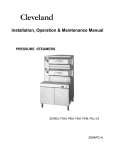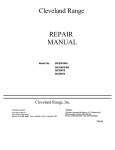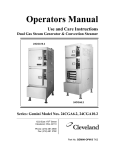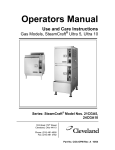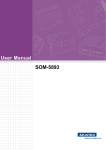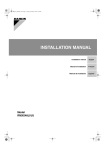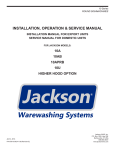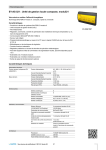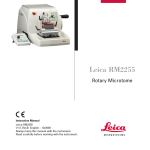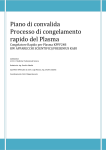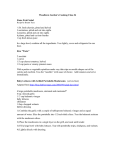Download Cleveland 36-CSM-16 Operator`s manual
Transcript
Installation, Operation & Maintenance Manual CONVECTION STEAMERS SERIES: 24/36CGM, CEM, CSM, VDM 42CKGM, CKEM, CKSM, CKDM 36CGM16300, 36C3EM1648, 36CSM16, 36CDM16 260-AOZ-A Operator’s Manual P/N-260AOZ-A Table of Contents INSTALLATION 4 Correct Installation 4 Water Quality 4 Drain Line Connection 4 Installation Safety 5 Installation Instructions 5 Installation checks 6 Gauge Pressure Reading with No Steam Flow* (Static Pressure) 7 OPERATION 8 Controls and Controls Panels 8 Steam Generator Controls 8 Steamer Compartment Control Panels 8 Start-up and Preheat 8 Cooking Operations 9 Cooking Operations for the Key Pad Control Panel 9 Manual Cooking Operation-Key Pad Controls 9 Automatic Cooking Operation-Key Pad Controls 10 Cooking Operations for the Dial Timer Control Panel 10 Manual Cooking Operation-Dial Timer Controls 11 Automatic Cooking Operation-Dial Timer Controls 11 Boiler Shutdown 11 Care and Cleaning 11 Maintenance 12 Preventative Maintenance-Descaling Instructions 13 TROUBLESHOOTING 17 Operators Troubleshooting Guide 17 Troubleshooting Notes 18 CONVECTION STEAMER COOKING INFORMATION 19 CONVECTION STEAMER TIMER SETTINGS 21 ______________________________________________________________________________2 Operator’s Manual P/N-260AOZ-A Installation CORRECT INSTALLATION You have purchased the finest Steam Cooking Equipment made. The following information we know will increase the productivity and life span of the equipment. Every product needs proper installation and with a steamer it is critical. The following is some important information you should check on before and during installation of the equipment. Water The quality of water you put into the steam generator is important. Poor quality water will create generator problems. Water is no longer just plain and simple water has many natural ingredients in it. These are called Total Dissolved Solids, or TDS. This includes calcium, iron, and other minerals in the water that collect in the steam generator Because of the droughts in many areas, water and TDS's are being pumped up from the bottom of the water systems. If these TDS are not pre-filtered out or cleaned out with a regular preventive maintenance program, your steam generator could deteriorate and develop holes. CHLORIDE is another chemical in our water creating many problems with all steam generators. When the generator creates steam from the water it also carries the chloride gas with it. These chlorides begin to eat away the inside of the generator and follow the steam into the compartments causing a rusting action (oxidation) as it goes along. A CARBON OR CHARCOAL FILTER must be installed on the incoming water line to the steamer if the chlorine is over 30 parts per million. These filters will remove the chloride. The WATER QUALITY STEAMER are as follows: Total Dissolved Solids Total Alkalinity Silica Chloride pH Factor REQUIREMENTS for your less than 60 parts per million less than 20 parts per million less than 13 parts per million less than 30 parts per million greater than 7.5 Drain Line Connection A proper drain line connection is important. If the drain line is clogged it can create a back up of pressure causing extreme and costly repairs. Figure 1. Drain Connections If the drain line is not large enough, not open at the end, or does not have a gravity flow; pressure and hot water will back up into the compartments. If any of these conditions exist and hot water does back up into the compartment someone could be seriously burned and injured. This can happen even with a correct installation if a drain cleaner is not used on a regular basis. An open and free flowing drain line IS REQUIRED for the proper cooking performance of a CONVECTION STEAMER. It helps create a swirling action around the products being cooked. This movement of hot steam around the product is your CONVECTION STEAM COOKING. DO NOT INSTALL UNIT OVER A FLOOR DRAIN. If it becomes an absolute must, using an 18.' stainless steel or aluminum pan turn it over and cut a notch in the side wall to fit over the drain line. Place the pan directly over the drain opening- DO NOT SEAL TO THE FLOOR. The steam from the drain line will collect on the under side and condense into the drain opening. DO NOT INSTALL GAS UNITS ON FLAMMABLEFLOORS OR NEAR WALLS. A flammable floor or wall is any material such as wood, linoleum, or vinyl that is easily ignitable and bums rapidly. The intent of these instructions is to provide meaningful information, which will help you obtain many years of production. Before installing the steamer, please read those instructions carefully to maintain your safety and warranty ______________________________________________________________________________ 3 Operator’s Manual INSTALLATION SAFETY WARNING Qualified installation personnel, working to all applicable local and national codes must accomplish installation of this equipment. Improper installation of this product could cause or damage. Do not store or use gasoline or other flammable Vapors and liquids in the vicinity of this or any other appliance. The flooring that will be directly under the boiler must also be made of a noncombustible material. Cleveland Range equipment is designed and built to comply with applicable standards for manufacturers. Included among those certification agencies which have approved the safety of the equipment design and construction: UL, A.G.A., NSF ASME, CSA, CGA, and others. Cleveland Range equipment is designed and certified for safe operation only when permanently installed in accordance with local and I or national codes. Many local codes exist and it is the responsibility of the owner and installer to comply with these codes In no event shall Cleveland Range assume any liability for consequential damage or injury resulting from installations which is not in strict compliance with our installation instructions. Specifically, Cleveland Range will not assume any liability for damage resulting from improper installation of equipment including, but not limited to, temporary or mobile installations INSTALLATION INSTRUCTIONS 1. These instructions must be retained by the owner/user for future reference. Gas-fired boilers are only to be installed in noncombustible areas that have provisions for s adequate air supply. The term "boiler’ will be used synonymously with "steam generator". 2. Position: For proper operation and drainage, the equipment must be level. It should be placed next to an open floor drain. DO NOT POSITION THE UNIT DIRECTLY ABOVE WE FLOOR DRAIN. Observe all clearance requirements to provide air supply for proper operation, as well as sufficient clearance for servicing. The surrounding area must be free and clear of combustibles. Dimensions and clearance specifications are shown on the specification sheet. 3. Install in accordance with local codes and/or the National Electric Code ANSI/NFPA No.70-1987. Installation in Canada must be in accordance with Canadian Electrical Code CSA Standard C22.1. The installer A wiring diagram is provided inside the base cabinet must ground equipment that is connected to electricity. P/N-260AOZ-A WARNING INJURY TO PERSONNEL AND EQUIPMENT DAMAGE May result from an improper drain connection. No connection lines are to be under the unit 4. Drain Line. The drain line outlet discharges exhaust steam and hot condensate. Connect 1-1/2-inch IPS piping (or larger) to extend the drain line to a nearby open floor drain. Up to two elbows and six feet of 11/2-inch IFS (or larger) extension pipe should be connected to the drain termination. No more than two pieces of Cleveland Range Equipment should be connected to one common drain line. The extension piping must have a gravity flow and vent freely to the air. This drain outlet must be free-vented to avoid the creation of backpressure in the steamer cooking compartments. To ensure a vented drain line, DO NOT UNDER ANY CIRCUMSTANCES, CONNECT THE DRAIN OUTLET DIRECTLY TO THE FLOOR DRAIN OR SEWER LINE. Do not run the drain line discharge into PVC drain piping or any other drain piping material not capable of sustaining 180' F operation. 5. Water Supply. Connect COLD water plumbing to the line strainer (Never conned hot water to the condensate water fill line strainer) Constant flow pressure must be maintained between 35 and 60 psi, and not experience a pressure drop below 35 psi when other appliances are used. If the water pressure exceeds 60 psi, a pressure-reducing valve must be installed in the water supply plumbing to reduce the water pressure to less than 60 psi. Locations and pressure data are shown on the specification sheet. 3/S-inch IPS plumbing is sufficient for water supply lines up to 20 feet in length, but water supply lines longer than 20 feet should be at least 1/2-inch IPS. Flush water supply lines thoroughly before connecting them to the unit. Use water, which is low in total dissolved solids content and low in gas content to prevent internal scaling, pitting and corrosion of the steam generator, and carry-over of minerals into the steam. Water, which is fit to drink, can still contain highly detrimental impurities. NOTE: If equipped with a kettle and kettle water fill swing spout, 3/8-inch (10 mm) hot and/or coldwater connection(s) will be required at the swing spout valve. 6. Turn on the cold water supply to the unit Ensure that the manual water valve, inside the base cabinet is open. 7. Fuel Supply. Connect the primary fuel supply in accordance with the following instructions. Location and other data are shown on the specification sheet. ______________________________________________________________________________ 4 Operator’s Manual P/N-260AOZ-A For Gas-Fired Steam Generators: Post in a prominent location, instructions to be followed in the event the user smells gas. This information shall be obtained by the consulting the local gas supplier. Install a sediment trap (drip leg) in the gas supply line, and then connect gas supply piping to the boiler gas valve piping. GAS-FIRED EQUIPMENT IS DESIGNED FOR INSTALLATION ONLY IN NONCOMBUSJJBLE LOCATIONS. THIS INCLUDES THE FLOOR-INC THAT WILL BE DIRECTLY UNDER THE EQUIPMENT Location, plumbing size, and pressure data are shown on the specification sheet. Boilers rated at less than 225,000 Btu require 3/4-inch 'PS gas supply piping, and boilers rated at 225,000 Btu or more require 1-inch II'S gas supply piping. Natural gas pressure must be between 4" -14" water column and LP gas supply pressure must be between 12" - 14" water column. NEVER EXCEED 14" WATER COLUMN (1/2 psi) GAS PRESSURE. If the gas supply pressure exceeds 14" water column, a pressure-regulating valve must be installed in the gas plumbing to reduce the gas pressure to less than 14" water column. Installation must be in accordance with local codes, or in the absence of local codes, with the National Fuel Gas Code, ANSI Z223.1-1984. Installation in Canada must be in accordance with Installation codes for Gas Burning Appliances and Equipment B149.1 and B149.2. Use a gas pipe joint compound, which is resistant to LP gas. Turn the gas valve control knob to ON (the word "on" the knob will be opposite the index on the valve's body). Test all pipe joints for leaks with soap and water solutions. Never obstruct the flow of combustion and ventilation air Observe all clearance requirements to provide adequate air openings into the combustion chamber. The appliance and it's individual shutoff valve must be disconnected from the gas supply piping system during any pressure testing of that system at test pressures in excess of 14" water column (1/2 psi or 3.45 k}'a). The appliance must be isolated from the gas supply piping system at test pressures equal to or less than 14" water column (1/2 psi or 3.45 kpa). A permanent 115-volt electrical connection is required at the junction box. The junction box location is shown on the specification sheet. The installer must electrically ground the unit. and pressure data are shown on the specification sheet. Incoming steam pressure must be regulated between 35 and 45 psi. A 3 /4inch strainer, equipped with a 20 mesh stainless steel screen, must be supplied and installed at the incoming steam connection point. Flush the steam line thoroughly before connecting it to the boiler. To ensure an adequate volume of steam, the branch steam supply line must be 3/~inch 'PS minimum. Connect the inverted bucket trap to the outlet end of the steam coil. Pill the trap with water before installing it. A permanent 115-volt electrical connection is required at the junction box. The junction box location is shown on the specification sheet. The installer must electrically ground the unit. For Electric-Powered Steam Generators: Connect electric power: location and data are shown on the specification sheet. Provide connection as required by the unit, either directly to the single contactor, or to the terminal block (when equipped with multiple contactors). Electric supply must match power requirements specified on the data plate inside the base cabinet. The copper wiring size must be adequate to carry the required current at the rated voltage. A separate fused disconnect switch must be supplied and installed. The installer must electrically ground the unit 3. Check that the manual water supply valve is open. For Steam Coil Steam Generators: Connect steam supply piping to the input side of the steam coil. Location For Direct-Steam Connected Steamers and Kettles: Connect steam supply piping to the input side of the line strainer. Location and pressure data are shown on the specification sheet. Flush the steam line thoroughly before connecting it to the steamer. To ensure an adequate volume of steam, the branch steam supply line must be 3/4 inch 'PSI 'minimum. Direct-steam-connected kettles require 1 /2-inch 'PS pipe if the kettle total capacity is 20 gallons or less, and 3/4-inch 'PS pipe if the total capacity exceeds 20 gallons.) A permanent 115 volt electrical connection is required at the junction box. The junction box location is shown on the specification sheet. The installer must electrically ground the unit INSTALLATION CHECKS Proper operation of the Cleveland Convection Steamer is dependent upon proper installation. After the steamer has been installed, a few quick checks could save unnecessary service calls. 1. The unit must be level. 2. The Convection Steamer requires a cold water connection for proper efficient operation. DO NOT USE HOT WATER. The cold water must be connected to the line strainer, located at the front lower right of the steamer base. 4. Check all water supply lines and valves for leaks. 5. Check that the water supply pressure and water quality meets the requirements of installation paragraphs. 6. On electrical units, verify that the supply voltage meets the voltage requirements on the rating plate inside the base cabinet and the voltage shown on the packing slip. Verify that the unit is protected with a separate fused disconnect and is properly grounded in accordance with the National Electric Code. ______________________________________________________________________________ 5 Operator’s Manual P/N-260AOZ-A 7. On all gas, steam-coil, and direct steam connected units, verify that there is a 115-Volt connection at the handy-box located on the left side of the base. 8. On all steamcoil units, the incoming steam pressure must be 35-50 psi. Less than 35 will not effectively operate the unit. Pressure in excess of 50 psi must be reduced (with a pressure-reducing valve) to 35-50 psi. 9. Check that the drain lines meet installation requirements specified in installation paragraph 4 WARNING INJURY TP PERSONNEL AND EQUIPMENT DAMAGE may result from an improper installation. 10. After completing checks 1 through 9, correct any deficiencies refer to the Start-Up and Pre heat instructions in the Operation section. Verify that the unit operates properly, make checks 11 and 12. 11.Check to ensure that the water in the boiler sight gauge glass automatically stays about 1/3 full when boiler is started up and operated. 12. Check to ensure that the steam pressure gauge registers 10 psi. The steam pressure is factoryadjusted to 10 psi Factory setting may shift due to shaking in transit and resetting will be required after installation. Proper adjustments and maintenance procedures am detailed on a separate data sheet entitled "Steam Pressure Adjustments." Adjustments should be made only by qualified service personnel- the factory pressure settings shown in the accompanying chart should never be exceeded. GAUGE PRESSURE READING WITH NO STEAM FLOW* (STATIC PRESSURE) Self-Contained Steam Generator; Gas or Electric Operating Pressure Switch 10 psi High Limit Safety Pressure Switch 15 psi Self-Contained Steam Coil Generator Operating Pressure Switch High Limit Safety Pressure Switch Steam Supply Pressure Range 10 psi 15 psi 35-45 psi Direct-Connect (to House Steam Supply) Steamer Pressure Reducing Valve 10 psi Steam Supply Pressure Range 15-45 psi ** With or without kettle ______________________________________________________________________________ 6 Operator’s Manual P/N-260AOZ-A OPERATION Operation of the Cleveland Range Convection Steamer is very easy. Each operator should read and understand the following procedures to effectively start, operate, and shut down the steamer each day. The owner(s) and operator(s) of this equipment should be aware that live steam could cause serious injuries, pay particular attention to the WARNINGS in this text. These instructions are to be retained by the owner(s)) and operator(s) for future reference. CONTROLS AND CONTROL PANELS There are two steam generator control arrangements and two steamer compartment control panels available for Cleveland Range Convection Steamers. The steam generator controls are illustrated in Figure 2. The steamer compartment control panels are illustrated in Figures 3 and 4. Compare these figures with the equipment supplied, and identify which control panel combinations applies. Steam Generator Controls The steam generator controls are located on the front face of the steamer base unit. The switches are to the left of the pressure gage, as illustrated in Figure 2 Most Cleveland Range Convection Steamers have a steam generator built into the base unit which supplies steam to the cooking compartments. However, an external steam supply may also be used. Units with a built-in boiler have both the POWER rocker switch and the STEAM momentary switch next to the pressure gage. Units with no internal generator have the POWER rocker switch only. They do not have the STEAM momentary switch. Installation, Use and Care Instructions Convection Steamer Convection Figure 3. Key Pad Control Panel Figure 4. Dial Timer Control Panel Steamer Compartment Control Panels Figure 3 illustrates the standard electronic controls: the Key Pad Control Panel. This panel has a rocker switch, a keypad, and a digital timer Figure 4 illustrates the optional electromechanical controls: the Dial Timer Control Panel. This panel has a rocker switch and dial timer. Steamer functions are the same for both the standard and optional panel configurations. Operating details are slightly different especially when setting the automatic operating time. For clarity two sets of instructions are provided for cooking operations. START-UP AND PREHEAT WARNING Do not attempt to start or operate the Convection Steamers during a power failure. Critical safety Circuits are not energized, and serious injury to personnel or damage to equipment may result. 1. Stan the steam supplies. The steam is either an integral steam generator boiler) built into the base unit, or an external steam supply. • For units without a built-in boiler, refer to the start-up procedures for the external steam supply and be sure it is running properly. As soon as the pressure gauge Figure 2. Steam Generator Controls ______________________________________________________________________________ 7 Operator’s Manual On the Convection Steamer registers 10 psi, steamer preheating may begin. Skip the remainder of step I, and begin step 2. • For units with a built-in boiler, fill the boiler with water and start the steam generator as described in step a. through d. below. a. Press the ON end of the POWER on-off rocker switch located next to the steam pressure gauge (Figure 2). The red indicator light in the POWER rocker switch turns on and the steam generator begins to fill with water units takes about 5 minutes. b. When the water level in the steam generator reaches a safe operating level, the amber light in the STEAM momentary switch turns on. Whenever the amber light is on, the heaters, steam supply, or burners are off, and no steam is being generated. The energy source (electric, gas, etc.) cannot be activated until the boiler contains sufficient water, indicated by the amber light. c. Press the STEAM (amber colored) momentary switch to produce steam in the boiler this activates the energy source (electric heaters, gas burners, or steam solenoid valve) and the amber light turns off. The STEAM switch must be pressed to restart the steamer after it is shut off for any reason (including a brief power interruption). No attempt should be made to operate the equipment during a power failure. NOTE: For steamers with built-in gas-fired boilers: If the burners fail to ignite in four seconds, a safety circuit energizes the system. In this event toggle the POWER rocker switch to the OFF position and back to the ON position. The amber light in the STEAM momentary switch lights. Wait five minutes, and then press the STEAM momentary switch to start the burner ignition cycle once again. d. About 20 minutes after starting the boiler in step C; the steam pressure gauge on the unit base should register 10 psi. 2. Preheat the Convection Steamer cooking compartments. For accurate, efficient cooking times, the cooking compartments should be preheated during startup. NOTE: With a steamer/kettle combination, if both must be used at the same time, always heat the kettle first. When kettle contents begin to simmer, steam pressure returns, the steamer compartments may be preheated a. Close the compartment door by gently swinging it shut. P/N-260AOZ-A b. Refer to timer setting instructions under Automatic Operation for the appropriate control panel. Set the Timer for each compartments to one minute, and start the cooking cycles. Steaming begins in each compartment. NOTE: On Convection Steamers equipped with electronic key pad control panels, the timer does not begin counting down until the cooking compartment reaches operating temperature. This may take 2 or 3 minutes if the steamer has not been operating. c. Steaming continues for the set one minute. When the preheating is completed, the steam automatically shuts off and a 3-second alarm sound. The Convection Steamer is ready for cooking operations. COOKING OPERATIONS The control panels mounted on the cooking compartments regulate cooking operations. Although cooking operations are similar for all Convection Steamers, regardless of control panel configuration, separate instructions are provided for each control panel type. Cooking Operations for The Key Pad Control Panel The electronic keypad control panel illustrated in Figure 3. The Cleveland Range Convection Steamer has two cooking modes: Manual and automatic. The Manual Mode provides continuous steaming and is turned on and off by the MANUAL/TIMED rocker switch. The Automatic Mode monitors cooking time and compartment temperature to provide accurate, efficient, uniform steam cooking. NOTE: Whether using timed or manual cooking modes, optimum steam heat transfer, and therefore a higher quality food product, is achieved when shallow, perforated, uncovered pans are used. WARNING STEAM may cause severe burns. Use extreme Caution when opening the steamer door. Turn face away from the steamer when first opening the door. Do not look into the cooking compartment until steam has dewed. KEEP HANDS OUT OF THE COOMNG COMPARIMENTTO PREVENT BURNS. Manual Cooking Operation Key Pad Controls Use manual mode for a continuous supply of steam for long periods, or if the required cooking time is unknown and frequent inspection is required. 1. Place the pan(s) of food into the compartment. ______________________________________________________________________________ 8 Operator’s Manual 2. To START the flow of steam, press the MANUAL end of the MANUAL/TIMED rocker switch, located below the timer. Steam immediately starts flowing into the cooking compartment. 3. If inspection is required during steaming, refer to the LIVE STEAM WARNING. Use extreme caution when opening the steamer door during steaming operations. 4. Although the timer cannot turn the steam off in manual mode, it can be used as a conventional cooking timer. Refer to the timer setting instructions under Automatic op-era don and set the timer The timer will count down the set period and sound the buzzer, but WILL NOT TURN OFF THE STEAM AFTER THE ALARM SOUNDS. 5. To STOP the flow of steam, press the of the MANUAL/TIMED rocker switch. Steam stops flowing into the cooking compartment. Automatic Cooking Operation Key Pad Controls Each Convection Steamer cooking compartment is equipped with an independent electronic digital timer, which has a maximum setting of 99 minutes and 99 seconds. Each timer is connected to a temperature-sensing device in the cooking compartment. THE SENSOR Circuit ALLOWS THE TIMER TO COUNT DOWN ONLY WHEN THE COOKING COMPARTMENT IS AT THE PROPER COOKING TEMPERATURE. This assures uniformity in the cooking times as the timer automatically compensates for food product defrosting and! Or heat-up time. 1. Place the pan(s) of food into the cooking compartment. 2. Clear and reset the timer. The timer can be set only when the COOKING ~ME display is clear Press the CLEAR key on the number pad to zero the timer 3. Set the Desired Cooking Time. The cooking time display contains four digits. The left two digits are minutes, and the right two digits are seconds. The display 12:34 is set for 12 minutes and 34 seconds. a. To set the cooking time: change the required cooking time to minutes and seconds, press the number keys for the minutes, and then press the number keys for the seconds. If the cooking time is 99 seconds or less, only press the number keys for seconds. b. Example 1. To set the timer for 1 hour and 15 minutes: Change 1 hour (60 min) and 15 minutes to 75 minutes. Press the following number keys in sequence: 75 00.The display will read 75:00 when properly set for 1 hour and 15 minutes. P/N-260AOZ-A c. Example 2. To clear the time numbers set in example 1, press the CLEAR key on the number pad. The display returns to 00:00. d. Press the following number keys in sequence: 1 3 0. The display will read 01:30, when set for 1.5 minutes. All seconds method: Change the 1.5 minutes to 90 seconds and press 90. The display will read 00:90, when set for 1.5 minutes. 4. Press the START/STOP key to start the timer. When the START/STOP key is pressed, steam enters the cooking compartment. a. THE TIMER WILL BEGIN TO COUNT DOWN ONLY AFTER THE COOKING COMPARTMENT REACHES PROPER COOKING TEMPERATURE. The timer automatically delays to compensate for Defrosting and! Or food product heat-up time. b. For example, a timer setting of 10 minutes may in fact take 11 or 12 minutes for the time to count down and the alarm to sound. This is normal. Heating the compartment and food to cooking temperature uses the additional time. c. To stop or reset the timer, press and hold the START! STOP key. The cooking time display returns to the last time setting. • To restart the same time, press the START/STOP key. • To set a new time, press the CLEAR key, and set the time. 5. When the timer counts down to zero, an alarm Sounds continuously. Press the START/STOP key to silence the alarm. The cooking time display returns to the last time setting. Either run this same setting again or clear and reset the timer 6. Example 4. To cook two 14 minutes cycles: Press the CLEAR key to clear the timer Press the following number keys in sequence: The display shows 14:00. Press the START/STOP)? Key to start the timer. When the display counts down to zero, the alarm sounds. Press the START/STOP key, and the display returns to 14:00. Press the START! STOP key to start the second 14-minute cycle. Cooking Operations for The Dial Timer Control Panel The dial timer control panel is illustrated in Figure 4 ______________________________________________________________________________ 9 Operator’s Manual The Cleveland Convection Steamer has two cooking modes: Manual and automatic. The Manual Mode provides continuous steaming and is turned on and off by the MANUAL/TIMED rocker switch. The Automatic Mode monitors cooking time to provide accurate, efficient steam cooking. NOTE: Whether using timed or manual cooking modes, optimum steam heat transfer, and therefore a higher quality food product, is achieved when shallow perforated, uncovered pans are used. WARNING LIVE STEAM may cause severe burns. Use extreme caution when opening the steamer door Turn face away from the steamer when opening the steamer door. Turn face away from the steamer when first opening the door. Do not look into the cooking compartment until steam has cleared. KEEP HANDS OUT OF THE COOKING COMPARTMENT TO PREVENT BURNS. Manual Cooking Operations Dial Timer Controls Use Manual mode for a continuous supply of steam for periods longer than the timer limits (60 minutes), or if the required cooking time is unknown and frequent inspection is required. 1. Place the pan(s) of food into the cooking compartment. 2. To START the flow of steam, press the MANUAL end of the MANUAL I TIMED rocker switch, located below the timer 3.If food inspection is required during steaming, refer to the LIVE STEAM WARNING on this page. Use extreme caution when opening the steamer door during steaming operations. 4. Although the timer cannot turn the steam off in manual mode, it can be used as a conventional cooking timer Refer to the timer setting instructions under Automatic Operation and set the timer The timer will count down the set period and sound the buzzer, but IT WILL NOT TURN OFF THE STEAM AFTER THE ALARM SOUNDS. 5. To STOP the flow of steam, press the TIMED end of the MANUAL/~MED rocker switch P/N-260AOZ-A Automatic Cooking Operation Dial Timer Controls Each Convection Steamer cooking compartment is equipped with an independent dial timer. This timer controls cooking compartment steaming cycle. Use automatic mode when an exact cooking time is required. Steam cooking begins when the timer is set and automatically stops when the timer counts down the set period. 1. Check that the MANUAL / TIMED rocker switch is in the TIMED position - If it is not press the ~MED end of the MANUAL/TIMED rocker switch. 2. Place the pan(s) compartment. of food into the cooking 3. Set the Desired Cooking Time. Turn the dial unit it points to the desired cooking time. When the dial timer is set, steam enters the cooking compartment. 4. When the timer counts down to zero, an alarm sounds for 4 seconds, and steam flow into the cooking compartment stops. Boiler Shutdown The red-lighted power switch must be shut off for 3 minutes a minimum of once every 8 hours to automatically drain highly mineralized water from the boiler, which reduces the formation of scale. See step J in CARE AND CLEANING instructions, which follow. CARE AND CLEANING The Cleveland Convection Steamer must he cleaned regularly to maintain its fast, efficient cooking performance, and to ensure its continued safe, reliable operation. 1. The boiler must be drained (Blowdown) after a maximum of 8 hours of use. If the boiler feedwater contains more than 60 parts per million of total dissolved solids, the boiler must have a Blowdown more often, the frequency depending upon the mineral content of the feedwater Blowdown means the boiler must be drained under pressure. THE BOILER BLOWDOWN IS PERFORMED BY SIMPLY SHUTTING OFF THE STEAMER'S REDLIGHTEDPOWER SWITCH WHILE THE BOILER IS AT NORMAL 10 PSI OPERATING PRESSURE. WHEN THEBOTTOM OF THE POWER ROCKER SWITCH ISPRESSED, ITS RED LIGHT GOES OUT, AND THE DRAIN VALVE AUTOMATICALLY OPENS, DRAINING THE BOILER. AUTOMATICALLY TIMED DRAIN WATER CONDENSER WILL PLUSH THE DRAIN FOR 3 MINUTES THEN SHUT OFF. AITER 3 MINUTES THE STEAMER IS READY TO BE RESTARTED. ______________________________________________________________________________ 10 Operator’s Manual P/N-260AOZ-A When steam is produced, the water in the boiler is being distilled. During this process, the minerals that come into the boiler with the water; remain in the boiler as the water boils away as steam. When allowed to accumulate, the water becomes highly mineralized, which results in erratic operation, lime build-up, corrosion, and premature electric heater failures. In some cases, complete boiler replacement becomes necessary, which is extremely expensive. By draining the boiler under pressure, most sediment present will be flushed down the drain. 2. The steamer is equipped with a drain in the back of the cooking compartment. No compartment should be o~ crated without the drain screen in place. This screen prevents large food particles from entering and possibly plugging the drain line. Any restriction of the drain line may cause a slight build-up of backpressure in the compartment, resulting in steam leaks around the door gasket. It also may adversely affect the convection action of the steam in the compartment, which is critical to optimum performance. Pouring USDA approved drain cleaner through the compartment drains once a week will help to ensure an open drain. An auger or "snake” may be safely used to clear obstructions in the compartment drains. Do not use a power auger, as damage to the plastic drain system will result. With the steamer off, open the cooking compartment doors and allows the steamer to cool before cleaning the cooking compartments and their components. 3. At the end of each day's operation, wash the pan slides door gaskets, and compartment interiors with mild detergent and warm water, either by hand or in a dishwasher Rinse thoroughly with clear water. Rinse water should drain freely through the compartment drain openings. If it does not, the drain must be cleaned before using the steamer. 4. To prolong door gasket life, always compartment door ajar when not in use. leave 5. Exterior Care: Allow steamer to cool before washing. Use the same cleaners and cleaning procedures as for other kitchen surfaces of stainless steel and aluminum. Mild soapy water, with a dear water rinse, is recommended. DO NOT ALLOW WATER TO RUN INTO ELECTRICAL Controls. Always turn off equipment power before using water to wash equipment. Do not hose down the steamer! MAINTENANCE Periodically, a qualified serviceman should be summoned for routine preventive maintenance. 1. The Blowdown procedure will not completely remove the mineral deposits that adhere to the top of the boiler. A boiler treatment specialist should do a chemical descaling. This should be done 4 times a year in average water conditions, but in poor water areas it may be needed more often. 2. A qualified Field serviceman should make periodic boiler inspections. 3. The cold water line strainer should be cleaned weekly. Cleveland Range supports a comprehensive network of Maintenance and Repair Centers (regional parts and service distributors) throughout the United States and Canada. Please contact your nearest distributor for the name of an authorized service agency in your area, or for replacement parts and information regarding the proper maintenance and repair of Cleveland Range equipment. In order to maintain the various agency safety certifications, only factory-supplied replacement pans should be used. The use of other than factory supplied parts will void the warranty. Preventive Keeping Maintenance and Record PREVENTIVE MAINTENANCE is the key to keeping your equipment in top condition. There are certain cleaning procedures that should be performed on a regular schedule. A. DAILY 1. Using a NON-CHLORINE DETERGENT a. Wipe out the interior of the compartments b. Wipe the face of the compartments c. Rinse the pan slides d. When the steamer is not cooking, leave the door open resting against the door latch. e. Wipe down the gaskets to prevent sticking 5. WEEKLY 1. Check the door gasket for wear and reverse or replace the gasket when needed. 2. Pour a liquid chemical descaler down the back of each compartment drain. WARNING Do not store gasoline or other flammable vapors and liquids in the vicinity of this or any other appliance. C. MONTHLY 1. Every 3 to 4 months the generator should be opened and checked for mineral build up or Chloride corrosion. ______________________________________________________________________________ 11 Operator’s Manual Look to see if the generator has a buildup of scale greater than the thickness of a business card or if the top is beginning to peel off in layers. If either one of these conditions is present, the generator needs to be chemically descaled by your CLEVELAND AUTHORIZED SERVICE AGENCY. a. Inspect more frequently in areas where the water conditions do not meet the Water Quality Requirements. 1. Change the boiler gasket every time you open the boiler for liability reasons. 2. Check to see that all door fasteners are tight. 3. P/N-260AOZ-A authorized service agency to make the REPAIRS It is in your best interest to maintain as many preventive maintenance records as possible. When contacted by a customer or service agency the manufacturer appreciates having this information available. The record keeping chart provided with the steam generator would assist you and your service agency. It will help you record your maintenance and service history of the equipment. If you have any questions concerning the proper installation and maintenance of your CLEVELAND STEAM COOKER call the Cleveland Service Department at (216) 4814900. Check to see that all steam, water, and electrical connections are secure. If any are loose contact your ______________________________________________________________________________ 12 Operator’s Manual Descaling is the most important maintenance you can perform on a steam cooker, and is required by the Cleveland Range warranty. The Descaling Pump System circulates DISSOLVE descaling liquid through the boiler of the steamer. Recirculating the descaling liquid provides a faster and more thorough cleaning process than the conventional soaking process. P/N-260AOZ-A Descaling Procedure Convection Steamers Pressure Steamers SteamPro/Convection Pro Modular Boiler Bases (Using the Descaling Pump System) Cleveland Range has developed the Descaling Pump System for owners of the Classic Series Convection Steamers, Pressure Steamers and SteamPro/Convection Pro series steam cookers. The Pump System provides a fast, highly efficient way to descale Cleveland Steam Cookers. The descaling Pump Kit includes a temporary hand-hole plate that is equipped with two descaling ports, one for the inlet and one for the outlet. This is to be used only for the Pump Kit and replaced at the end of the procedure. The Descaling Pump System consists of a submersible pump, a 5-gallon reservoir pail, Hand-Hole plate with ports, the feed and drain hoses, and the temporary hose couplings necessary to connect the system to the Classic Series Cleveland Steamers. 13 ______________________________________________________________________________ Operator’s Manual P/N-260AOZ-A NOTE: Only service technicians authorized by Cleveland Range should perform the descaling procedure. Read and be familiar with the procedure before starting. Follow the procedure exactly as given. DISSOLVE Descaling Liquid Use only Cleveland Range DISSOLVE descaling product. Five gallons of descaling liquid will be needed during this procedure. Avoid unnecessary contact with the descaling product; read and follow safety precautions on the container label. Overview of Pump Descaling Procedures Below is a summary of the descaling procedure using the Pump System. The detailed procedure is given on page 3 and 4. Descaling should be done as required by your maintenance schedule. The process takes about an hour and a half to complete. Part A – Equipment Setup • • • • Turn off the steamer to drain the boiler Remove the handhold plate of the boiler and attach the hand-hole plate with the descaling ports Connect feed and drain hoses Fill reservoir pail with DISSOLVE descaling liquid and insert pump. Part B – Descaling • • • • • Turn on power to steamer; boiler will begin to fill Turn on pump Monitor liquid levels in boiler and pailregulate level using hand valves Let liquid circulate for one hour Turn OFF steamer, pump; boiler will drain Part C – Clean Water Flush • • • • • DISSOLVE Order Quantities Container Size Qty Part No. 1-gallon bottles 6 106174 5-gallon pail 1 1061741 5-gallon pails 12 10617411 5-gallon pails 24 10617412 • Turn On steamer; boiler will fill Empty the pail of spent solution, refill with fresh water Route Drain hose to floor drain Turn pump ON and circulate for 5 minutes, monitoring water levels Turn OFF pump; close all valves; turn OFF steamer; boiler will drain Replace hand-hole plate, check gasket Part D –Take Down and Return to Service • • • Turn ON Steamer; boiler will fill Remove hoses and couplings; Activate steam switch; unit ready to operate 14 ______________________________________________________________________________ Operator’s Manual P/N-260AOZ-A Detail Procedure- Using the Descaling Pump System A. Equipment Setup 1. Turn the Steamer OFF; the boiler will drain automatically 2. Open the door at the base of the unit 3. Remove the hand-hole plate and gasket. Discard old gasket. 4. Inspect the boiler for scale build up. 5. Remove any loose scale within reach that is around the hand-hole plate. 6. Install Hand-Hole plate with the descaler ports. And a new gasket. 7. Attach the 3” Feed and Drain nipples with the attached unions to the INLET and OUTLET ports. 8. Connect the ½” Feed Hose with attached union to the bottom of the 3” nipple. 9. Connect the ¾” Drain Hose with the attached union to the top 3” nipple. 10. Make sure both Feed and Drain Valves are closed. Drop the open end of the Drain Hose into the reservoir pail. 11. Fill the reservoir pail with 5 gallons of DISSOLVE descaling liquid. 12. Lower the Pump into the descaling liquid. Proceed to Part B, descaling. Hand-Hole Plate with Descaler Ports for Feed and Drain Hoses. Sight Glass located on Left. B. Descaling 1. Turn the Steamer power ON. 2. Turn the Pump ON and open the Feed Hose Valve to the boiler. Let the boiler fill with descaler to just above the top of the Sight Glass before opening the Drain Hose Valve. Make sure the Drain Line Hose is in the pail with the pump. • Do not allow the liquid to fall below the pump intake. Water may be added to reservoir pail to keep pump intake submerged. • Watch for liquid at the sight glass 3. Open the Drain Hose Valve when the descaler reaches the level just above the to of the Sight Glass. 4. While the descaler solution is circulating, keep an eye on the liquid level in the pail. Do not allow the level to fall below the pump intake or to overflow in the pail. The required level can be maintained by controlling the flow with the Feed Hose Valve 5. Let the pump circulate descaler for 1 hour. 6. After 1 hour, turn the Steamer power OFF; the boiler will automatically drain. 7. Turn OFF the pump; close both the Drain and Feed Hose Valves. Proceed to Part C, Flushing. ¾” Drain Hose and Control Valve-top ½” Feed Hose and Control Valve-bottom 15 ______________________________________________________________________________ Operator’s Manual P/N-260AOZ-A B. Flushing 1. After the boiler has drained completely, it must be flushed with water. 2. Turn the Steamer back ON; it will begin to filling. 3. Remove the Pump from the pail. Remove the Drain Hose from the pail. 4. Empty the spent descaling solution, refill it with fresh water and put the pump back in. 5. Do Not put the Drain Hose back in the pail; instead, route it to a floor drain. 6. While the boiler is refilling, observe the water level in the sight glass. 7. When the level reaches the middle of the sight glass, turn ON the pump and open the Feed Valve of the steamer. 8. When the level reaches the top of the sight glass, open the Drain Valve of the steamer. 9. Let the pump run 5 minutes; keep an eye on the water level in the pail; additional water may be added to keep the pump submerged. 10. After 5 minutes, turn OFF the pump, close the Feed and Drain line Valves, turn the OFF the steamer power; the boiler will automatically drain. Proceed to Part D. Takedown and Return to Service Feed Line Hose Drain Line Hose D. Takedown and Return to Service 1. The Steamer descaling procedure is complete; loosen the hose clamps, remove the hoses. 2. Replace the Hand-hole plate with the original. 3. Turn the Steamer back ON; the boiler will refill. 4. When the amber Steam Light comes on, activate the STEAM switch to bring the unit back to operating temperature 5. Record the current date in your descaling maintenance records 16 ______________________________________________________________________________ Operator’s Manual P/N-260AOZ-A Troubleshooting OPERATORS TROUBLESHOOTING GUIDE This troubleshooting guide includes a list of symptoms that may be encountered during the operation and maintenance. The first column on the left (problem) describes these symptoms. The second column lists possible causes for the problem listed in column one. The third column lists remedies for the problems and causes columns one and two. The causes and remedies are listed in the am Or they should be checked, with the least costly and easiest to repair listed first. The third column also refers to notes that are grouped at the end of the troubleshooting guide. Refer to these notes when instructed to do so. Do not try to correct a problem that requires an authorized service representative as this may adversely affect warranty coverage. PROBLEM POSSIBLE CAUSE REMEDY/REFERENCE Switch light does not turn on: When POWER switch is pressed switch. On. Power turned off at main disconnects, SWITCH Turn on power at main disconnect switch. POWER switch light on and Steam generator does not fill. Water supply to steamer shut off. Open water supply valves. Water line strainer is clogged. Clean water supply strainer Water sensors shorted by scale, Deposits. Descale steam generator with USDA Approved descaler. Inoperative controls or solenoid See note #1. No water in steam generator. See steam generator does not fill (above). Gas models only Gas supply valve closed. Electric models only Heating elements covered with Scale. Turn off steam generator and open gas supply valve. Refer to Service Manual. Descale steam generator with USDA approved descaler Electric models only Heating elements damaged. See note #1. Water sensors covered by scale Deposits. Descale steam generator with USDA Approved descaler. Inoperative controls. See note #1. hot water instead of cold water Connected to condenser fitting Make proper connections. Refer to Service Manual. Water supply to condenser turned off. Open water supply valve. Condenser waterline strainer is clogged. Clean out condenser water supply line. See note #1. Water supply line to the conCondenser blocked, broken, or leaking. Repair or replace solenoid. See note #1. Inoperative condenser solenoid. Replace solenoid. See note #1. Inoperative five controls. Turn off electricity at main disconnect Switch. See note #1. Drain clogged or covered. Clean drain with USDA approved drain cleaner. Door gasket or door parts worn. See note #1. Steam Generator does not make any steam. Abnormal amount of steam Coming from drain. Steam and I or water draining around compartment door 17 ______________________________________________________________________________ Operator’s Manual PROBLEM P/N-260AOZ-A POSSIBLE CAUSE REMEDY/REFERENCE Steamer not level See note #2. Hot Water to con denser See note #2. Steam generator scale buildup. Descale steam generator with approved Descaler Steam nozzle scale buildup. See note #1. Steam solenoids scale buildup See note #1. Electric models only Voltage too low for unit. See note #4. Electric models only Faulty heating element or controls. See note #1. Operating in manual mode. Switch to timed mode for timer to be Effective. Stuck open steam valve See note #1. Inoperative five controls inside Cabinet. Turn off electricity at main disconnect switch. See note #1. Water leaking from bottom of Cabinet. broken or loose plumbing inside steamer cabinet. Turn off electricity at main disconnects switch and close water supply valve(s). See note #1. Water leaking from water pipes or drain lines. Plumbing needs repair See note #3. Food takes too long to cook. (Cook in perforated pans when possible.) Not enough steam movement in compartment. Hot water conConnected to condenser line. Make proper connections. Refer to Service Manual. Pans too close to the bottom of cabinet. Put pans in racks near top of cabinet. Steam generator scale buildup. approved descaler Descale steam generator with USDA Compartment overloaded with too much food. Put less food in pan. Use fewer pans. Voltage too low for unit. See note #4. Suggested cooking times are usually listed for cooking at sea Level Extend cooking times for altitudes above 2500 FEET. Juices and /or food leaking from pans. Put a solid pan under perforated pans to catch drippings, or put less food in pan. Reduced steam flow into cooking Compartment. Steam flow does not stop when timer stops. Compartment bottom dirty with food drippings. TROUBLESHOOTING NOTES 1. If problem is inside the steamer, call an authorized Service representative Cleveland Range will not pay for Non- warranty repair centers. 2. Proper installation of the Convection Steamer Responsibility of the owner or installer Refer to Cleveland 3. Repair to external wiring should be done by a Licensed Electrician. 4. For more information on products and services, contact your nearest Authorized Service Representative. 18 ______________________________________________________________________________ Operator’s Manual CONVECTION STEAMER Cooking Guidelines Introduction: Steam Cooking is an excellent way to prepare countless foods. With large and small quantities you will find cooking to be efficient, economical, fast and convenient. Food can never burn-pans will never boil over-there is no heavy lifting of water in pots-no scouring of containers-no waiting for boiling to start. Steam cooking is efficient, economical and convenient. From the Steamer to the steam table, it saves money in labor/time, and, of course, the quality and consistently remains the same. Seafood: Steaming seafood is an excellent method of cooking a variety of seafood. From the freezer directly into the steamer gives you, the operator, portion control on P/N-260AOZ-A expensive seafood products. Steamed fish is tender, succulent, and flaky and table ready in a matter of minutes. Vegetables: Steam cooking vegetables, either fresh or frozen, enhances color, improves flavor, and helps retain vitamins when recommended timer settings are followed. Steaming fresh vegetables on perforated pans gives best results. Meat: Steam provides an even, intense and penetrating heat, which, because of its nature, cooks meat with minimal shrinkage. The meat is tender, moist and flavorful. Stews, pot roasts, ham and corned beef are excellent steam cooked. Steam tenderizes stewing fowl. It produces excellent meat for sandwiches and salads, both moist and savory and is easily sliced. Desserts: Many kinds of cornstarch pudding and custard desserts are prepared by steaming. Fruit desserts such as steamed “Baked Apples” are another suggestion. Core the apple and arrange on a shallow pan. Fill the cored apple with cinnamon and sugar, then steam. If desired, browning under the broiler may finish the apples. Applesauce is another steam application, as are stewed pears or peaches. Dried fruit, properly marinated, turn out beautifully. Additional Ideas: There are many applications for steam cooking besides vegetables and seafood: • Eggs can be soft cooked, coddled, hard cooked, poached, scrambled, and made into custard or pudding. 25 dozen eggs can be hard cooked in 12 minutes using three 12” x 20”” x 2½” perforated pans in one compartment of the steamer. • Momentary steam blanching of fruits, including citrus and pineapple, simplifies skin removal. • Dumplings, steamed breads, muffins, hot cereal, pasta, noodle and rice can be prepared or reheated in the steamer. • Beef and other meat, cooked by steaming, is moist, tender and flavorful. The meat drippings from the catch pan can be used to make gravy soups or clear stock, as a salt free broth. • Turkey, chicken and other poultry are tender, juicy when steamed then combined into a casserole, added to BBQ sauce, or browned under the broiler. Chicken pieces can be breaded, steamed, then finished in the deep fryer. It is crisp, delicious, and juicy. • Hot Dogs, sausages and other variety meats remain plump and juicy when steamed. • Entrees such as lasagna, macaroni and cheese, or beef stew can be prepared from scratch. Frozen institutional packs can be reheated in the steamer. It is not necessary to cover. 19 ______________________________________________________________________________ Operator’s Manual P/N-260AOZ-A Sizing Up Pan Capacity: How Much? How Many? How to estimate portion size and number of servings from a standard steam table pan. • A 12” x 20” x 2½” (65mm-1/1GN) solid pan will hold 1-7/8 gallons or 240 fluid ounces (30 liters or 7200ml) Portion Size 10 oz (300ml) 8 oz (240ml) 6 oz (180ml) 4 oz (120ml) 2 oz (60ml) 1 oz (30ml) • 240 Fluid Ounces Produces (7200ml) Number of Servings 24 30 40 60 120 240 Type of Product Stew, Casserole, Lasagna Soup, Bisque Soup, Bisque Mashed Potatoes Sauce Number of servings of cooked vegetables from one 12” x 20” x 2½” perforated pan. (65mm-1/1GN) Frozen Vegetables Yields: 10.0 lbs. (4.5kgs) Approx. 50-3 oz (90ml) servings 7.5 lbs. (3.4kgs) Approx. 30-3 oz (90ml) servings 5.0 lbs. Approx. 25-3 oz (90ml) servings For Units with Mechanical Timers: Cleveland’s Electronic Controls With Compensating Thermostat: • • • • • • Durable and Reliable Simple and Easy to Operate Automatically adjusts the cooking time for the volume of product steamed Manual Bypass Switch for Constant Steam Audible Signal for cooking time completion Automatically resets to the original time after cycle is completed Consistent-Worry Free Cooking Results! 20 ______________________________________________________________________________ Operator’s Manual P/N-260AOZ-A Convection Steamer Suggested Timer Setting Guidelines Electronic Controls with the Compensating Thermostat Timer settings are approximate due to the differences in food quality, age, shape and the degree of doneness desired. It is not necessary to add water. Perforated pans are recommended. Starred items (*) must be cooked in solid pans. Items marked with two stars (**) require handling in two steps. First steam for approximately ½ the time shown, remove from steamer, separate thawed portion, or stir, and return to steamer for the time remaining. The compensating feature of the timer allows the cooking compartment to reach temperature before the preset time starts to count down. VEGETABLES: Fresh Artichoke 12 Asparagus, spears 4 Beans, green, 2” cut 6 French cut 4 Whole 6 Broccoli, spears 3 Flowerets 2-3 Chopped Brussels sprouts 4-5 Cabbage, 2 Whole to remove Leaves for cabbage rolls Carrots-baby whole 10 Sliced, 7-8 Diced Cauliflower, Flowerets 4-5 Whole 10 Celery, Dai. Cut 1½” 3 Diced 2 Minced 1 Corn, yellow, whole On cob, 6 Cobbettes 6 Eggplant, sliced, 1 Mixed Vegetables Mushrooms, Whole 1½” 3 Sliced 1 Onions, diced, sliced 2-3 Whole 4 Peas, green Potatoes, whole 8 oz. 30-35 Peeled, quartered, 12-19 Fresh peeled, diced 8-10 Potatoes, sweet, 30-35 Whole Spinach leaf 2 Chopped Squash, acorn halves Butternut, quartered Squash whipped* Spaghetti squash, halves 15-18 Tomatoes, whole, sliced* 1 Turnips, whole 20-25 Zucchini, sliced 2-4 Fresh Frozen 6 5 5** 4 2-3 1-2 6-8 4 6 3 2 3-4 1 2 12** 12** 3-4 1 2 2 21** 21** 20** 2-4 Frozen SEAFOODS: Steam all seafood on a perforated pan with catch pan Clams in shell 3-5 Cod fillets, 5 oz. 3 4 Portions Crab legs, king 4-6 Snow crab 2-4 Crab, live, 4 oz. 3/4 - 1 lb. 12 Halibut, 6-8 oz. 4-6 6-8 Portions Lobster, whole, 1 lb. 7-9 Lobster tails, 8 oz. 8-10 Defrosted, butterflied 4-6 Mussels in shell 2 Oysters in shell 2-4 Red snapper, 8 oz. 4-5 4-5 Salmon steak, 8 oz. 6 7 Shrimp, 10 ct. per lb. IQF 3 4-6 5lb. Block, peeled & 6-8 Deveined 30 ct. 5lb. Block, green, (nested pan) 26-30 ct. 10** EGGS (Medium Sized): Hard cooked for egg Salad, potato salad Soft cooked Coddled Poached in a cup Scrambled* FRUITS: Blanch for peeling Fresh: Avacado Apple, cored Grapefruit Orange Apricot Pineapple, whole Dried: add water to re-hydrate Apple Apricot Peach Pear Prune 10-12 3 6 2-3 6-7** 1 1 1 1 1 2 10 10 10 10 10 21 ______________________________________________________________________________ Operator’s Manual P/N-260AOZ-A MEATS & POULTRY: Meats and poultry in nested pans, as juices can be used for gravy, sauces, beef stock and soups. The portion size, thickness, grades, should be considered when selecting a timer setting for doneness. POULTRY: Fresh Turkey, whole 6-8 min./lb. Chicken, 5-8 oz. Breaded piece 18-20 min. halves, 1 1/4-1 1/2 lb. per half 20-24 min. 6 min./lb. 4-6 min./lb. 2-4 min./lb. STEAKS: Using a 3/4” to 1” steak, the steaming time listed below produces a “rare” steak. A “well done” steak is first steamed to the “rare” stage, then broiled or grilled for 1 1/2 minutes on each side. This “well done” steak shrinks less, is more tender and juicy; and, when served, is the same size as the “rare” steak. Sirloin Patties Chopped 8 oz Ribeye, 8 oz. Top butt steak 6 oz. 8 oz. Filet Mignon, butterflied – 4 oz. 4 min. 4 min. 4 min 6 min. 3 min. 3-4 min. 4 min. 5 min. 8.min Strip steak - 10-oz. 12 oz. 5 min. 7 min. T-bone 12 oz. 16 oz. 18 oz. 22 oz. 5 min. 8 min. 8 min. 10 min. Frozen 6-8 min./lb. PORK, SAUSAGE, HOT DOGS: Pork, Chop, 4 count/lb. 10 min. Italian sausage, 4 oz. 10 min. Ribs, 3lb. and down 20-26 min. Hot-dogs, 8 count/lb. 2 min. BEEF: Cubes, 1 1/2” 6-7 min./lb. Ground chuck for chili 4 min./lb. Pot-roast, choice 8-12 min./lb. Rump roast, choice Boned, rolled, tied 12 min./lb. Meat loaf, 4lb. Loaf 5 min./lb. Liver, baby beef, 8oz. 2-4 min./lb. Corned beef, 6-8lb. cut, add 1/2” water Pan 20-23 min./lb. 6 oz. 8 oz. 10 oz. 16 oz. (Chateaubriand) PREPARED ENTREES: Full Size Pans Cabbage rolls, stuffed* Cover with tomato Sauce & serve Casserole dishes* Beef Stew Stroganoff Lasagna* fresh Reheat ea. serving 4” Fresh Frozen 25 min. 20 min. 20-25 min 20-25 min. 20-25 min 6-8 min. 25-30 min. 25-30 min. 25-30 min. 12 min. DEHYDRATED FOODS: Potatoes* 2 ½” random sliced Plus 5 cups cold water /lb. RICE & BEANS: Rice, long grain 4 cups cold water/lb. Beans, pre-soaked overnight, 1 lb. Beans = 1 ¼ qt. Water Beans* unsoaked, 1 lb. Beans x 1 ½ qt. water Refried beans, 2-#10 cans 12 min. 17 min. 45 min. 2 ½ Hours 15-17 min. PASTA: Steam in nested pans. Place pasta on 2 ½” perforated pan used as a liner in a solid 2 ½” pan. Cover pasta with cold water. Egg noodles, 1 ½” wide 4-6 min. ** Lasagna noodles 10-12 min.** Macaroni, shells, elbow 10-12 min.** Rigatoni 10 min. ** Spaghetti, vermicelli 8 min.** Spaghetti, regular 8 min.** 22 ______________________________________________________________________________ Operator’s Manual P/N-260AOZ-A NOTES: 23 ______________________________________________________________________________























